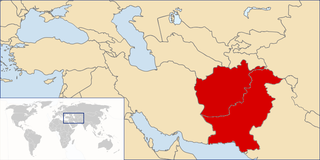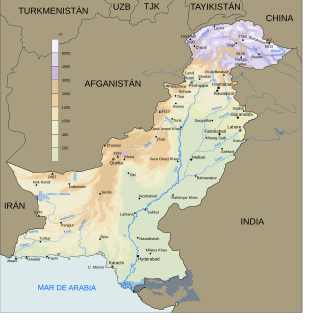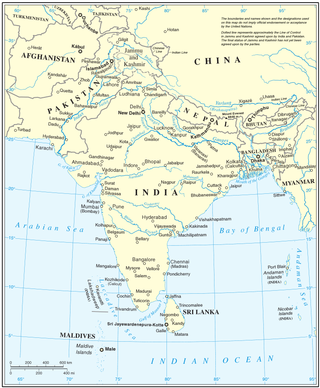Related Research Articles
1992 was a year mixed with euphoria and tragedy for Pakistan. While Pakistan won the finals of the Cricket World Cup, thousands died in the flooding that occurred in the northern regions of Pakistan as a result of torrential rains swelling the Indus river. The Nawaz government inaugurated a few projects in the province of Punjab towards the betterment of road networks and ordered a military operation in the province of Sindh to counter the growing language riots and ethnic tension.

Pakistan's climate varies from a continental type of climate in the north, a mountainous dry climate in the west (Baluchistan), a wet climate in the East (Punjab) an arid climate in the Thar Desert, to a tropical climate in the southeast (Sindh), characterized by extreme variations in temperature, both seasonally and daily, because it is located on a great landmass barely north of the Tropic of Cancer.
The 2012 Pakistan floods began in early September 2012, resulting from heavy monsoon rains in Khyber Pakhtunkhwa, Upper Sindh, Southern Punjab and Balochistan regions of Pakistan.

In August 2013, Pakistan and eastern Afghanistan experienced heavy rain that led to flash flooding. More than 180 died as a result of the floods.

On the night of 26 April 2015, a severe storm hit areas of Khyber Pakhtunkhwa, Pakistan, causing considerable damage in the cities of Peshawar, Nowshera, and Charsadda. The storm featured heavy rains accompanied by hail and high-speed winds of over 120 kilometers per hour. As a result of the storm's damaging effects, 45 people were killed and over 200 were wounded.
Operation Radd-ul-Fasaad is a codename of a combined military operation by the Pakistani military in support of local law enforcement agencies to disarm and eliminate the terrorist sleeper cells across all states of Pakistan, started on 22 February 2017. The operation is aimed to eliminate the threat of terrorism, and consolidating the gains of Operation Zarb-e-Azb which was launched in 2014 as a joint military offensive. It is further aimed at ensuring the security of Pakistan's borders. The operation is ongoing active participation from Pakistan Army, Pakistan Air Force, Pakistan Navy, Pakistan Police and other Warfare and Civil Armed Forces managed under the Government of Pakistan. More than 375,000 operations have been carried out against terrorists so far. This operation has been mostly acknowledged after Operation Zarb e Azb.
From February to April 2019, widespread flash flooding affected large parts of Pakistan, most severely in Balochistan, KPK, Punjab, and other provinces. Pakistan has been hit by three major waves of rain and flooding over the course of more than one month. The first wave of rain began on 20 February, leading to flooding in to Khyber and Balochistan, therefore many villages and several cities have been evacuated, and more than 1,500 families has been rescued alone in Balochistan and many in other states. The 20 February rain and thunderstorms caused flash floods in the Lasbela area. The main areas affected were Turbat, Tump, Nasirabad and Dasht where 300 people were displaced due to the flood. These people were then moved to camps established by the Provincial Disaster Management Authority (PDMA). Casualties have came mostly due to roof collapsing amid heavy rains and flash flooding. Khyber Pakhtunwkha has witnessed the most deaths till now, 40, alongside Balochsitan has faced 26 casualties with more than 9 in Punjab and other places. Due to rain, flood and storm casualties are increasing.
In mid-March 2019, monsoonal downpours caused widespread flooding and landslides across South Asia.

In 2016 Pakistan experienced higher rainfall than normal (10-20%), especially in the pre-monsoon season. Heavy monsoon rains are common in the region. This led to multiple periods of flooding, landslides, and damage particularly in Northern Pakistan. The Swat River overflowed and multiple landslides occurred around Pakistan including in Khyber Pakhtunkhwa, Gilgit-Baltistan, Azad Jammu, and Kashmir.

In May 2022, floods affected several parts of Afghanistan, killing 429 people. It was later reported the 182 people died due to flooding in August, as well as 40 people in July and 19 in June. From June to August, just as the country was recovering from an earthquake in Khost Province, floods hit again, killing 19 in June, 39 in July, and 182 others in August.

From January to October 2022, excessive rainfall and widespread monsoon flooding occurred in the South Asian countries of Afghanistan, Bangladesh, India, Nepal, Pakistan, and Sri Lanka. It has become the region's deadliest floods since 2020, with over 3,700 people dead.
The events listed below are both anticipated and scheduled for the year 2023 in Pakistan.
The 2023 Pakistan floods occurred from March to July of 2023, caused by monsoon rains which returned to Pakistan after nine months after the 2022 Pakistan floods. Floods worsened at the end of June due to upcoming monsoon rains. At least 159 people were killed, including many children.

Flooding affected parts of South Asia since March of 2023, killing many and destroying buildings.
The events listed below are both anticipated and scheduled for the year 2024 in Pakistan.
Events in the year 2024 in Afghanistan.
Since 29 February 2024, flooding affected various regions across the country, including Sindh, Balochistan, Khyber Pakhtunkhwa, and Gilgit-Baltistan. At least 40 people were killed and 62 injured in the floods. Floods caused by heavy rains caused widespread destruction, disrupting normal life and damaging infrastructure. The government declared a state of emergency in several areas, and relief operations were launched by various agencies, including the Pakistan Navy, Pakistan Army, and the Frontier Corps.
References
Notes
Citations
- 1 2 3 "Another 29 Killed In Afghanistan Rains". Channels TV. 11 May 2024. Archived from the original on 20 April 2024. Retrieved 20 April 2024.
- 1 2 "Death toll from Afghanistan's floods exceeds 330". Mehr News Agency. 11 May 2024. Archived from the original on 11 May 2024. Retrieved 11 May 2024.
- 1 2 "At least 50 killed in heavy rains, floods in Afghanistan's Ghor province". Al Jazeera. 18 May 2024. Retrieved 18 May 2024.
- 1 2 "Northwestern Pakistan landslide: More than 40 killed in heavy rain and snowfall". Microsoft Start . 6 March 2024. Retrieved 11 May 2024.
- 1 2 3 OCHA (22 April 2024). "Pakistan: Flash Floods Flash Update No.2 (as of 21 April 2024)". ReliefWeb. Archived from the original on 22 April 2024. Retrieved 11 May 2024.
- ↑ "Heavy rains and floods kill over 100 across Pakistan and Afghanistan". Voice of America. 16 April 2024. Archived from the original on 20 April 2024. Retrieved 21 April 2024.
- 1 2 3 "Weather tracker: rains bring deadly flash floods to Afghanistan and Pakistan". The Guardian. 19 April 2024. Archived from the original on 20 April 2024. Retrieved 21 April 2024.
- 1 2 3 "Massive rains, flash floods kill nearly 100 in Pakistan". The Express Tribune. 20 April 2024. Archived from the original on 20 April 2024. Retrieved 21 April 2024.
- ↑ "Torrential rains claim 3 more lives in KP; death toll rises to 46". 20 April 2024.
- 1 2 "Afghanistan floods death toll climbs to 90". Kuwait News Agency. 23 April 2024. Archived from the original on 9 May 2024. Retrieved 9 May 2024.
- ↑ "MSN". MSN .
- ↑ "More than 100 killed across Pakistan and Afghanistan as flash floods and heavy rains sweep the region". Archived from the original on 18 April 2024. Retrieved 21 April 2024.
- ↑ "Dozens killed in Afghanistan as heavy rains set off flash floods". Al Jazeera. 14 April 2024. Archived from the original on 16 April 2024. Retrieved 15 April 2024.
- 1 2 "Hundreds killed as storms lash Pakistan and Afghanistan". Al Jazeera. 16 April 2024. Archived from the original on 17 April 2024. Retrieved 17 April 2024.
- ↑ "Afghanistan floods devastate villages, killing 315". Deccan Herald . Reuters. 12 May 2024. Archived from the original on 12 May 2024. Retrieved 12 May 2024.
- ↑ "Afghanistan floods leave more than 300 dead, thousands homeless, UN says". France 24. 11 May 2024. Archived from the original on 11 May 2024. Retrieved 11 May 2024.
- ↑ "Over 200 Dead In Afghanistan Flash Floods In A Single Day". NDTV. 11 May 2024. Archived from the original on 11 May 2024. Retrieved 11 May 2024.
- ↑ UNOSAT (16 May 2024). "Mudflow impact in Burka District, Baghlan Province, Afghanistan as of 14 May 2024 - Imagery Analysis: 14/05/2024 Published 16/05/2024 V2". ReliefWeb . Retrieved 17 May 2024.
- ↑ "Afghanistan: Flash floods in Takhar kill 20, injure 80". Amu TV. 11 May 2024. Archived from the original on 11 May 2024. Retrieved 11 May 2024.
- ↑ "Afghanistan: Floods in Herat kill three, including a child". Amu TV. 11 May 2024. Archived from the original on 11 May 2024. Retrieved 11 May 2024.
- ↑ "Flash floods kill hundreds in Afghanistan, Taliban says". Express & Star . 11 May 2024. Archived from the original on 11 May 2024. Retrieved 11 May 2024.
- ↑ "Flash floods due to unusually heavy seasonal rains kill at least 68 people in Afghanistan". Associated Press. 18 May 2024. Retrieved 18 May 2024.
- ↑ "Lightning, rains kill 36 people in Pakistan". NPR. 15 April 2024. Archived from the original on 16 April 2024. Retrieved 15 April 2024.
- ↑ "Lightning, rains kill 49 in Pakistan as authorities declare a state of emergency in the southwest". AP. 16 April 2024. Archived from the original on 17 April 2024. Retrieved 16 April 2024.
- ↑ "MSN". MSN .
- ↑ "Pakistan Flooding, Storms Kill Dozens". Archived from the original on 19 April 2024. Retrieved 21 April 2024.